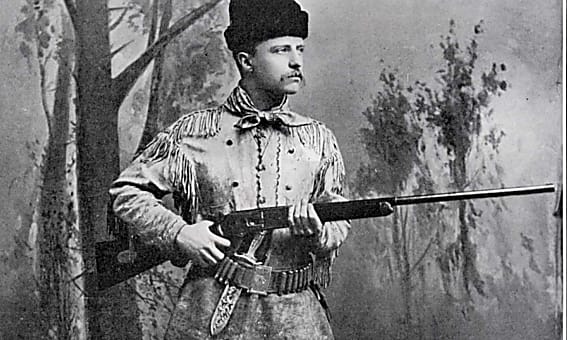
Mental Floss has a new podcast with iHeartRadio called History Vs., about how your favorite historical figures faced off against their greatest foes. Our first season is all about President Theodore Roosevelt. Subscribe on Apple Podcasts here, and for more TR content, visit the History Vs. site.
“The finest hunting ground in America was, and indeed is, the mountainous region of western Montana and northwestern Wyoming,” Theodore Roosevelt wrote in The Wilderness Hunter, an 1893 memoir of his adventures at the frontier. There, Roosevelt encountered thick forests, towering peaks, and vast plains veined with streams and rivulets. He pursued the continent’s megafauna, from white-tailed deer and beaver to bison, moose, and “grisly bear,” while reveling in the fresh air and lively stories of his fellow outdoorsmen.
The forest also held secrets. On one of his hunting expeditions in this primeval landscape, Roosevelt heard an anecdote that stood out from the usual tales on the trail. Roosevelt had studied the flora and fauna of the West, but had never heard of a creature as strange as the one at the center of this yarn. “It was told by a grisled, weather-beaten old mountain hunter, named Bauman, who was born and had passed all his life on the frontier,” Roosevelt relayed in his memoir. “He must have believed what he said, for he could hardly repress a shudder at certain points of the tale.”
When Bauman was still a young man, Roosevelt recalled, he and a friend set out to trap beaver in a rugged river valley in what was then the Montana Territory. They went up a mountain pass where, the year before, a lone trapper had been killed by an unidentified beast, “the half-eaten remains being afterwards found by some mining prospectors who had passed his camp only the night before.”
They left their horses at the foot of the pass and climbed up to a small glade, where they pitched camp. With some hours of daylight remaining, they went to set their beaver traps in the stream, and returned to camp just as the sun dipped behind the screen of pines. With a shock, they found their lean-to flattened and the contents of their packs scattered among bear-like footprints in the earth.
Bauman’s companion made a torch from the campfire and peered at the tracks. “Bauman,” he said, “that bear has been walking on two legs.”
Bauman laughed off this idea, and the two trappers soon went to sleep in their repaired camp. But Bauman was awakened in the night by a fetid stench and the fleeting shadow of “a great body” in the entrance of their shelter. He shot his rifle, and the beast retreated to the forest.
The following day, after long hours at the streams checking their traps, the two hunters returned to camp—and found their lean-to destroyed once more. The same large footprints trailed away from the camp, toward a brook, where they appeared “as plain as if on snow.” Bauman had to admit that, whatever the creature was, it had escaped on two legs.
They hardly slept that night, for the sounds of twigs snapping in the gloom alerted the men to the animal’s presence. As their fire blazed, the trappers sensed it waiting, and heard its woeful cry echoing through the woods.
Bauman and his friend decided that the next morning would be their last in this creepy vale. Together, they gathered their empty traps from the stream dividing the pine thickets, plagued by a sense of being followed. Yet sun shone brightly in the clearing as they packed their bags, and the fears of the previous night began to seem silly. Bauman volunteered to retrieve the last three traps from a nearby river, which ended up taking a few hours.
He returned to a scene of horror. The still-warm body of his friend was leaning against a tree with four awful fang marks piercing his broken neck. Telltale footprints surrounded the unfortunate victim. The beast had not devoured the flesh, but merely “romped and gamboled round it in uncouth, ferocious glee.” The hunter had become the hunted.
Neither Bauman nor Roosevelt ever identified the culprit as a sasquatch, or Bigfoot, but its bipedal stance, hideous smell, and prolonged screaming in the northern woods dovetails with descriptions in Indigenous stories (though sasquatches aren't bloodthirsty murderers in the legends). Likewise, Bauman’s identity is a mystery. He may have been Carl L. Bauman, who according to the Montana Historical Society was born in Germany in 1831, moved west in the 1860s, and died March 20, 1909 near Melrose, Montana. Beyond that brief clue in the Montana Historical Society journal, Bauman remains as enigmatic as the tale he shared with Theodore Roosevelt.